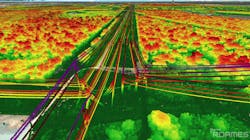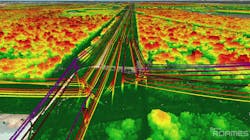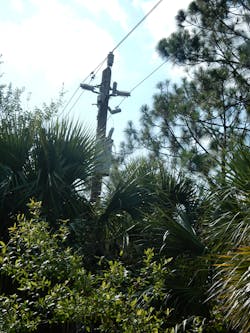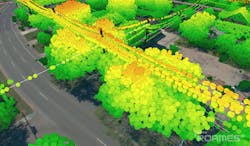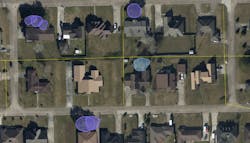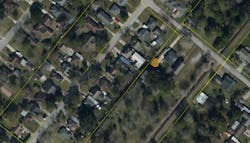Unlock the Value in Vegetation Management
U.S. utilities spend nearly $7 billion annually to keep up with the maintenance required to reduce the risk of vegetation intrusions into the network. And yet, vegetation remains one of the largest causes of service interruptions. As one of the most expensive line items in an annual budget, every utility shares the common goal of getting the most value for their vegetation management (VM) budget. With a VM plan that’s more precisely defined and executed, utilities can deliver longer-term reliability while greatly reducing the risk to their networks.
Now more than ever, utilities can extract more value from their vegetation management spend. New tools, technologies and approaches provide information at scale that has never been available before. Precise vegetation locations, tree health and species analysis and risk-informed work planning and optimization are all within reach.
Vegetation management practices have evolved over the past century when transmission and distribution lines became a part of our landscape. Initial approaches to vegetation management were focused on cycle-based trimming schedules. In this scenario, each year field crews worked a fraction of the circuits on the overall network, applying a trim specification for vegetation in the right of way (ROW). Trees were trimmed, but often also required revisits or rework in order to reduce the risk to the network due to out of cycle growth.
As vegetation management practices progressed, cyclical trimming programs gained additional insight from surveying and field tool technology. Advancements such as hand-held GPS and tablet-based tools allowed utilities to more precisely direct their funds towards the areas that required the most attention within the cycle. While this provides more value for each dollar in the VM budget, improvements are possible.
Every utility wants to understand current conditions in greater detail and deliver better value for every dollar. The question is, how do we collect better details, prioritize our work for more impact, while continuing to spend every available dollar on effective treatment?
Unlocking Additional Value in Vegetation Management
When exploring how to maximize the value of a VM budget, the application of science and technology plays a key role in the improvement of business processes. Next-generation vegetation management tools support decision-making with the use of scientific data and identify areas where financial efficiencies can be gained. This next step in the evolution of VM capitalizes on existing domain knowledge and leverages emerging technology. It also takes advantage of applied scientific approaches, which open the doors for utilities to obtain a significantly higher level of precision to further optimize field work and the contracts around it.
As more and more data has become accessible (and at a reasonable price to obtain that data) utilities are able to better direct funds toward the areas that deliver the most impact. For example, condition-based trimming has always had limitations — utilities could identify particular areas that required trimming within their network, but they could not identify specific trees. The possibility existed that funds were used for trimming that were not necessarily directed towards the highest priorities.
One Step Further
Effective prioritization remains at the heart of any vegetation management plan. Can a utility take its prioritization practices one step further to introduce more exacting requirements? Can they:
- Maximize the marginal value of every dollar spent to improve reliability?
- Maximize the efficiency of trimming work in field?
- Hold the arborists accountable for clearly defined work on specific trees?
Precision is Key
As the physical world becomes more digitized, and as the costs of obtaining detailed data and integrating it are lowered, utilities now have access to a much greater understanding of the precise nature of the physical world surrounding its assets. We can now use spatially large analyses –- using techniques previously only available to intelligence agencies -– to identify all risks in an area and separate out priority work areas from deferral areas.
In addition to ongoing maintenance to clear the lines, utilities are now able to find and address the trees in declining health that pose the greatest risk to the network –- trouble trees –- and solving those problems before they actually become a problem. No utility struggles to find noticeably dead and dying trees in visible areas but finding the less obvious trouble trees and emergent issues outside of the cycle has always been a challenge.
Where once there was uncertainty as to what trees were likely to fail, there is now a much greater degree of certainty in identifying, trimming, or removing trouble trees – those with a greater likelihood of failure with the ability to impact utility T&D assets. By using analytics to create an advantage, utilities can prioritize the cycle trim schedule to cut smarter.
This detailed data benefits all participants in the VM process.
- More precise data enables the utility to allocate and spend its budget more effectively while also lowering the risks to their network.
- The arborist now has the tools, the information, and the specifics of what is required to bid the work more accurately, successfully remove tree hazards and maximize the marginal value of the team being mobilized.
- And the management and oversight of the field work maximizes the efficiency of the trimming work and enables a validation process to ensure that the field work was executed properly and the reliability risks were resolved.
Emerging Technologies Enable Even Greater Precision in VM Practices
Technological advances such as LiDAR and hyper-spectral satellite imagery, machine learning and artificial intelligence, cloud computing, analytics and automation help utilities develop a condition-based risk assessment and target their VM dollars towards the trees that pose the greatest risk to the network. For the first time ever, these technologies are available at the scale and cost required to transform vegetation management practices without diverting significant funding from the task of clearing vegetation.
The next evolution in vegetation management begins with a valid understanding of the network as well as the state of the vegetation that surrounds the network. Once that is understood, the probability of outage due to encroachment and trouble trees can be modeled. Combining the probability of failure with the impact of outages based on downstream customers and critical services, a utility can better understand — and proactively address — the risks to their network.
Recent technological advances are helping utilities achieve this risk assessment goal.
- LiDAR and satellite imagery provide macroscopic information about vegetation risks, enabling the user to understand where the issues are, and are not.
- Machine learning and artificial intelligence (ML/AI) has revolutionized the ability to find dead and failing trees, and to align this information to the species that are most likely to do damage to a utility network.
- Cloud computing enables the computation of comprehensive risk models that can identify different risk levels and the required funding associated with the mitigation of those detailed risks.
- Analytics and automation have made it possible to assemble this massive amount of data into something that is useable and actionable.
- Real-time applications allow a utility to assign and track detailed prescriptive vegetation plans that will reduce uncertainty for field crews and better align costs to the work completed.
- Lastly, automated change detection can validate the work and ensure that the risk was resolved without requiring field verification.
The use of emerging technologies can pay for itself many times over through cost savings and reliability increases. With this level of analysis, the VM budget can be reconciled to prioritize work that addresses the greatest risks to the system, thus optimizing the budget, increasing cost savings, improving reliability, reducing risk and efficiently executing a VM plan. With the new ability to identify specific locations of trimming and tree removal, ambiguity and risk is reduced when scoping the work, making bids far more efficient and enabling a higher level of accountability for the arborist.
Vegetation Insight, Leidos’ VM solution, was built to minimize the barriers to entry of this emerging technology and maximize business impact with the lowest friction possible. Leidos has applied this tool to take advantage of all of the data available to a utility, whether from a satellite, LiDAR, or Google Street View and apply science-based solutions such as species identification to arrive at a much more detailed, specific and defensible VM strategy for its utility customers.
For example, when using our analysis to determine network location and vegetation encroachment, one utility saw a reduction in the frequency of vegetation related outages by 26% (p=0.005). Another utility gained key insight as to how a precise trim scope reduces the risk of uncertainty in bidding large circuits, bringing costs in line with their smaller circuits where previously some were nearly twice the price per span.
Future Vision
Vegetation and our electrical infrastructure are always going to be at odds with one another. With evolving technology at our fingertips, we can build a world where risks are understood, resource use is more efficient, costs are decreased and reliability is maximized. Optimization of where to treat, what exactly to treat and how to treat based on a holistic view of the vegetation risk on the network is not out of reach. From the collection of data, to managing work in the field and everywhere in between, the vegetation management landscape is evolving for the better.
Josh Wepman ([email protected]) is the chief technology officer for Leidos Commercial Energy. He leads Leidos’ Commercial Energy products and solutions organization where he works with internal and external teams to understand Leidos’ client’s toughest challenges and create innovative solutions. Josh has worked in the energy and critical infrastructure industries for 25 years covering large scale telecommunications, cybersecurity, application development, analytics and business process optimization.
Ben Jarmak ([email protected]) is a solution architect in Leidos' Commercial Energy organization where he uses his distribution engineering experience to bring new technologies, applications and tools to market. Ben has worked on transmission and distribution data management, analysis and quality control for both asset and vegetation management and frequently presents key findings to involved stakeholders.
About the Author
Josh Wepman
Josh Wepman ([email protected]) is the chief technology officer for Leidos Commercial Energy. He leads Leidos’ Commercial Energy products and solutions organization where he works with internal and external teams to understand Leidos’ client’s toughest challenges and create innovative solutions. Wepman has worked in the energy and critical infrastructure industries for 25 years covering large scale telecommunications, cybersecurity, application development, analytics and business process optimization.
Ben Jarmak
Ben Jarmak ([email protected]) is a solution architect in Leidos' Commercial Energy organization where he uses his distribution engineering experience to bring new technologies, applications and tools to market. Jarmak has worked on transmission and distribution data management, analysis and quality control for both asset and vegetation management and frequently presents key findings to involved stakeholders.
